Kategorie: ‘Norway’
Internship in Trondheim
- Biology M.Sc.
- Norway, Trondheim
- St. Olavs Hospital, Trondhiem
- 06/2023 – 11/2023
Before the stay (planning, visa, vaccinations, travel, …):
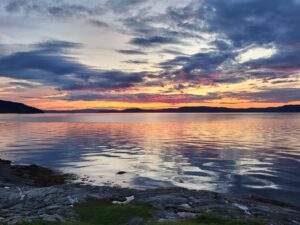
© Leona Grundel
I started an internship at St. Olavs hospital in Trondheim, which is the university hospital of NTNU,
after already spending the summer semester at NTNU. I therefore had arrived in January already
and had therefore already spend a long winter and beautiful spring their.
Regarding finding accommodation in Trondheim, the student welfare organization SIT organizes
student housing for incoming Erasmus people. Those accommodations are generally cheaper
(while I was there around 4500 NOK) than rooms on the private market (generally between 5500-
7500 NOK).
If you plan on spending the spring semester in Trondheim, your chances are good to get a place
with SIT. If you are not a student, you would have to find something on the private market, which
unfortunately usually just offers 12-months leases (July to July), few 6-months leases (July to
January; January-June) and almost never shorter leases.
Arriving in the fall semester is more difficult. Spots are very limited, and you may want to check
out the private marked. But if you like the adrenaline rush and the suspense, you can also wait
until just two weeks before you are supposed to arrive in Trondheim. I know of some people that
still got a spot with SIT this close to their departure date. NTNU and SIT are a bit last minute that
way. But speaking from experience, not everyone gets a place with SIT in fall semester.
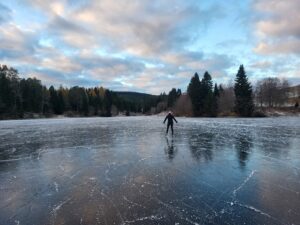
© Leona Grundel
Unfortunately, the private market housing situation in fall is not ideal either as explained above.
Also, if you extent after having started your semester abroad, be ware that, at least for an
extension into the fall semester, SIT is not guaranteeing you a place to stay. There priority is to
make space for the newly arriving exchange students which do not have the chance to go room
hunting on site.
With all the hustling around finding housing and doing all the Erasmus paperwork, the departure
time arrives quickly. Especially when arriving in summer I recommend planning a longer trip on
your way up north and visit Norway west coast or checking out Denmark and Sweden. You could
do the same if you arrive in winter but its much less fun. It’s going to be dark 80 % of the time
anyways, although I have to admit, that snowy Norway looks breathtaking.
I decided to drive up the 21 h to Trondheim with my car because I wanted to have the opportunity
to spontaneously go on road trips and other places. Although Norway in the middle of winter is
icy and snowy, the ‘’highway’’ E6 is usually ok to be driven. But it is a one lane street leading over,
around and through mountains, so in case of fresh snow you might have to wait a bit until the
streets are cleared. However, it was still cold and sometimes we drove for hours without seeing

© Leona Grundel
car, while it was down to -18°C outside.
Having a car in Trondheim was especially useful since I did not have to rely on others or the public
transport to go on road trips or cabins that were further away, but you can do a lot of stuff without
one as well. Public transport in the city area is really good, and if you plan ahead you can also
reach places in the periphery a couple hour away (Just make sure to check the time table
beforehand, some bus lines drive sparsely on Sundays). And even if you want to go somewhere
where there is no good public transport connection, there are tones of Facebook groups in which
you will find yourself new friends that have cars:D Speaking of Facebook: You’ll need it.
Everything relies on Facebook: Every restaurant or club as a Facebook page (or Instagram
account) and NTNUI groups (NTNUs sports group, of which there is every sport you can imagine)
communicate and inform through it. Also, you’ll need an empty phones storage when coming
here. There are apps required for everything – laundry, NTNUI sports groups, for identification,
public transport, your student ID, renting cars…
Experience in the host country (accommodation, daily life, free time, …):
Trondheim is a bit like Aachen – a moderately sized student city with great surrounding nature.
Living in Moholt, one of the main student villages (‘’studentby’’), was awesome. This is where the
biggest chunk of Erasmus people lives. It is therefore the center of the Erasmus life. You can
spontaneously meet up in someone’s apartment (if the roomies are ok with it of course) and spend
a fun night hanging out, cooking together or drinking. But be ware, stores don’t sell alcohol after
8 pm on weekdays and 6 pm on weekends.
Next to a washing room, there are also a grocery store, a library, a café/restaurant, a gym and
even a hairdresser on the premises. Without leaving the student city you can do a BBQ, play
beach volleyball, or hang out at ‘’Lofted’’ (the common room) to play table tennis, play board
games or study (they have free coffee!).
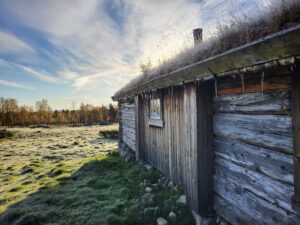
© Leona Grundel
On more thing that I really appreciate are the student run rental organizations. Check out what
the university offers, since some of these can also be used/accessed by non-students. ‘’Restore’’,
for example, is located in Moholt studentby. They collect and hand out donated furniture and
equipment to students for free. If you get one of the limited spots on their opening days you can
get everything from stools and desks to bed covers to plates and cutlery to bikes and what not.
At the end of your stay, you can easily bring that stuff back so that future exchange student benefit
from them.
Furthermore, “Bumerang” is located in Moholt studentby. They rent out everything you may need
for the outdoors for free, from tents to skies & snowboards to ice skates to fishing rods. The same
goes for the non-profit organization ‘’BUA’’. In winter, lakes are usually frozen so you can
spontaneously go ice skating there and the fjord is perfect to try out fishing or just spend the long
midsummer nights there with good food and some friends.
Continuing with the student run organizations, the “Koiene” group allows NTNUI members to rent
out their cabins in Trøndelag. Their cabins are super basic, no electricity or running water, but it
is a great way to spend a weekend away and out in nature with your friends. Here are some
pictures so you can see how beautiful it is out there. Also in fall and winter, some cabins are
perfectly located far away from any light pollution to stay up late and, with a bit of luck, see
northern lights.
Experience at the host institution (professional, cultural, …):
The internship that I did was actually my Master’s Thesis. I therefore spend most of my time at
Campus Øya in the laboratory of St. Olavs hospital. I really recommend working in their
laboratories if possible since their laboratory equipment is modern. I learned a lot, not just
academically but also about differences in how institutions are run. Be aware that there are
differences in formalities and expectations. For me it was difficult in the beginning to figure out
what requirements needed to be met. Although I tried to communicate a lot, there were still some
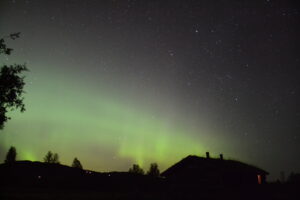
© Leona Grundel
misguided expectations on both sides that needed to be overcome on the way.
Furthermore, it was very interesting to talk to my colleagues with different backgrounds and to
find out about the academic structures in Norwegian research institutions, as well as the working
mentality. They really leave the office at 4 pm on the dot!
I also took a Norwegian language course. Even though you might not need the language
afterwards, it was nice to get a short introduction into the language. Especially for German
speakers it is not that hard. As a plus, you’ll also be able to understand a bit of Swedish or Danish
since their languages are closely related.
Tips for interested students:
I don’t have many more tips other than the ones I have already mentioned: Be aware of the
housing situation for the winter semester; be conscious about what it means to move somewhere
that is dark and cold most of the year; and just try to experience as much as possible. Also, for
when you arrive at NTNU, I can only encourage you to join different groups at NTNUI and maybe
try out something new. As mentioned, they have virtually everything. Normal stuff like, handball,
Taekwondo and rugby, but also fencing, diving, disc golf, dog training, horseback riding and
climbing. I for example picked up sailing and kayaking which was awesome. After the (kinda
costly) 3-days beginners course you are allowed to go to their weekly trainings for free. All of
these activities, as well as many cabin trips and meeting friends help you a lot with making it
through the dark winter hours.
Writing a master thesis in Norway
- Molecular and Applied Biotechnology M.Sc.
- Norway, Longyearbyen
- UNIS Svalbard
- 06/2023 – 04/2024
Application/Finding an Internship
The EU project FACE-iT is an international collaboration among several research institutions aimed at studying climate change in Arctic fjords across various trophic levels. Upon discovering the project online, I came across a thesis topic advertised on their website and promptly contacted the responsible professor. Following an online interview, I received confirmation of the suitability of the master thesis project. While the university regularly advertises thesis topics on their website, it’s also beneficial to reach out directly to professors to explore potential topics. Fortunately, I had previous experience with many professors at the University Centre in Svalbard (UNIS) due to my highly recommended bachelor exchange semester there.
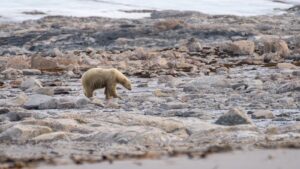
© Lina Lettau
Accommodation & Living Expenses
As a UNIS student, you are automatically allocated housing in the student dormitory, managed by Samskipnaden. Applications can be submitted through their website, offering various options, including a single room with a shared kitchen for approximately 10 people (510€), sharing a room with one other student, or one to two-person apartments with individual kitchens. Living expenses in Longyearbyen are on par with mainland Norway, making them approximately double the cost of living in Germany. The local supermarket impressively stocks a wide range of fresh fruits and vegetables for those who can afford them.
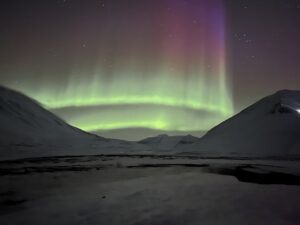
© Lina Lettau
Given the town’s small size, there aren’t many other ways to spend your money (except for drinks at one of the four bars), so most of my expenses went towards food and outdoor equipment.
Everyday Life/The Internship
My internship focused on marine molecular ecology, leading to a varied daily routine. This ranged from boat samplings in the summer to molecular lab work in the autumn, and data exploration during the polar night. Fieldwork days can be quite extensive from my experience. Nevertheless, the average Norwegian workday appeared to be a standard 9 to 5, except when the skies cleared after an extended period of overcast weather. In such cases, the department would empty as everyone ventured out for skiing or hiking. In terms of social life, if you come to Longyearbyen thinking you’re at the end of the world and should lead a hermit-like existence, think again. You’ll be living in student housing with approximately 200 people, and activities like hikes, ice climbing, skiing, snowmobile tours, games, dinner parties, knitting, puzzles, and movie nights are popular. Weekends were often spent in rural cabins outside of town.
Free Time/Tips
Two months before:
Ensure your passport is up-to-date. No visa is required, but you’ll be traveling outside of the EU.
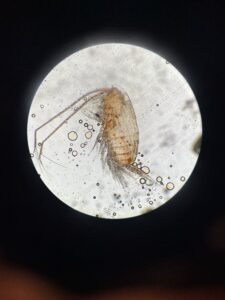
© Lina Lettau
Book your flights with SAS or Norwegian; if you’re under 26, they offer youth discounts.
Apply for a certificate of good conduct (Fuehrungszeugnis) in English and bring it with you. Guns are carried for polar bear protection outside of town, and you’ll receive rifle training upon arrival (no prior experience needed).
Two weeks before:
Stock up on items that might not be available or could be expensive in the one and only super market Longyearbyen. For me, this included tea, dried soy and seitan, drawing supplies, batteries, tech equipment, toiletries, fairy lights, analog photo films, guitar strings, and hair scissors.
Join all relevant Facebook groups, as Longyearbyen heavily relies on them. The most important ones include Ros & Info Longyearbyen (providing information on ongoing events and occurrences in town), Kjøp/salg/bytte/gi bort – Longyearbyen (an online second-hand marketplace), and Svalbard studies spring/autumn semester 20XX (with “XX” representing the year, depending on when you are here).
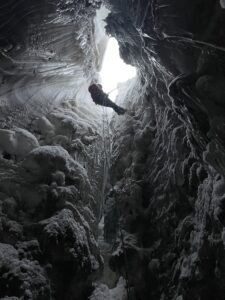
© Lina Lettau
Upon Arrival:
Explore Bruktikken, a donation-based free shop with a diverse range of items, including clothing, books, equipment, decoration, electronics, and more. You can even find second-hand bedsheets and towels there, so don’t overpack. Pro-tip: Work there and sort through the latest donations for yourself while earning money.
Become a member of Svalbard Turn to access the gym, swimming facilities, climbing, and various social sports.
Attend Sprakcafe on Mondays in the library to practice Norwegian while mingling with locals in town.
I also warmly recommend thoroughly reading the UNIS website section on Arrival and living in Longyearbyen – UNIS.
Conclusion:
My research experience at UNIS in Longyearbyen was a valuable opportunity that deepened my understanding of climate change in the unique Arctic ecosystem of Svalbard. Natural sciences and the great outdoors converge in a way that few other places on earth offer.
Internship in Oslo
- Molecular and Applied Biotechnology, M.Sc.
- Norway, Oslo
- Universitetet i Oslo
- 05/2023 – 07/2023
After looking for some alternatives outside the EU, I decided to search for an internship position in the EU and apply for the Erasmus+ funding. This was was with comparably few preparation time and less bureaucracy possible. To find an internship position, i visited the websites of universities I found interesting and searched for departments that work on topics that are interesting to me. I did not search for specific open position, but just wrote short formless mail to the professors or group leaders, introducing me and stating my interest. This worked very well and I had to contact less than five research groups to find an interesting project.
To find a place to live, I took a look at the offers from the University. In Oslo, this is SIO. They care for student cafeterias, housing, and do even have a fitness studio. The hosing application was simple and is worth a try. Even if you might be not quite sure, in which category of applicant you belong, you can ask them or also try what sounds best to you. The people there were very friendly and everything was very uncomplicated. For me it was important to live in a shared flat, because this makes meeting new people much easier and you will never be alone. Living expenses are indeed like everyone says more expensive than in Germany, but regarding the inflation in Europe and the the weak exchange rate of the Norwegian krown at the time, normal groceries were not too much more expensive.
I lived together with other students, mainly from Italy and one person from Germany, that made an Erasmus semester in Oslo. The dormitory was full of Erasmus students and it was easy to meet new people. Unfortunately, I arrived at the end of the Semester and most other students left after my first of three month. If possible, it might be an asset to plan you stay according to the semester start in you city of destination as then are much more social activities.
I travelled to Norway by car, what made it possible to carry a bicycle with me. But travelling by Train and Ferry or by Plane also works very well. For the mobility in Oslo, I can highly recommend to either bring a bicycle with you from home, or buy a cheap one in Oslo. Public transportation in excellent in Oslo, but also expensive, especially if you do not have a student status. By bike you are much more flexible and see much more of the city.
In the Institute I worked, the working atmosphere was very nice and welcoming. As a student I was invited to all meetings and free time activities, but never felt forced to participate anywhere. The first part of the Internship was very relaxed and some things did not work right away, but my supervisors were very supportive and always helped me when necessary. They also handled the pressure very healthy in the final part of the internship. I did work a lot in the last weeks, but this decision was left free for me and I was not set under pressure by my supervisors.
All in all, my Internship was a very enriching experience. I made my internship in a field I was so very proficient in before. This made it quite challenging for me, but on the other hand I feel like I have learned an incredible amount of things during these three month.
I planned to do some vacation after the internship and my supervisors helped me to plan the submission so that this is possible.
My Research Internship at the NTNU Trondheim
- Psychology B.Sc.
- Norway, Trondheim
- Norges Teknisk-Naturvitenskapelige Universitet
- 01/2023 – 05/2023
Preparation
My path to the Research Internship at the Institute of Psychology at NTNU was surprisingly
easy. I met the head of the institute at NTNU during a guest lecture and wrote him an email
after his lecture asking about the possibility of an internship. 5 minutes later I had my
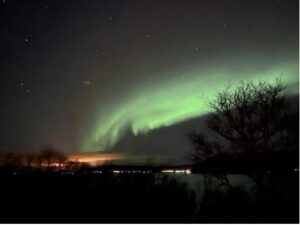
Northern lights on the way to Tromsø
© Selina Fußwinkel
acceptance and could choose my starting time flexibly. So I can at least give you a tip for an
internship at this institute: Just ask! Internships are by no means typical here, but they are
easy to implement and welcome
Traveling to Norway and Housing
I quickly found someone via Facebook who was able to take me to Trondheim by car. Even
though the journey takes longer than by plane, I can only recommend it. Especially the part
through Norway itself is very scenic and gives you a first impression of the country.
In Trondheim itself, I didn’t stay in a student dorm like most people, but in a shared flat near
the city center (Buran). This turned out to be a very good decision for me. Some of the
student dorms are further out and the bus connections at night are not particularly good,
which is why the walking distance from the city to my shared flat was often very practical. It
also gave me contact with Norwegians, which is otherwise not so easy due to the ERASMUS
bubble. Finding a flat was also very easy. The website Hybel offers a really wide range of
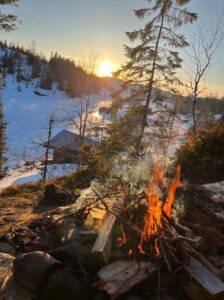
BBQ at the Mevasskoia Cabin
© Selina Fußwinkel
shared flats, which even write to you themselves. So if you prefer smaller and more personal
shared flats to student dorms, I can highly recommend it, even if it is of course a bit more
expensive. But I had a very good time with my two flatmates!
My Internship
I really enjoyed my research internship at the Institute of Psychology for the whole 5 months.
However, you have to show a lot of initiative. There are a lot of researchers working on
different projects at the institute, which were presented to me at the beginning. However, I
was completely free to decide where I wanted to work. On the one hand, this meant that I
could devote myself to the projects that I found most exciting in terms of content, but on the
other hand, it also meant that I first had to get an overview, write lots of emails and ask
where it was possible to work. So it took 1-2 weeks until I could really get started and find my
projects and tasks. After that, however, the whole thing became a no-brainer and I always
had something to do. The work itself was a lot of fun. I mainly did literature research,
analyzed data sets and co-wrote papers. If you do a good job, you’re even accepted as a co-author.
In general, I was given a lot of trust and I had a lot of freedom in my work and little
control, also meaning that if you need help, you have to communicate that directly as well. I
found this working environment and the atmosphere perfect. I was very warmly received by
the team and we had lunch together every day. I especially enjoyed the contact with the PhD
students. In summary: Super nice team, exciting content, lots of initiative needed!
I was absolutely thrilled with the university itself! There are numerous cafés, beautifully
designed study rooms and libraries (especially the library in the old building on the
Gløshaugen campus), bookstores, small supermarkets and very good (but also very
expensive) food in the canteen. Especially important: Every Wednesday is Cinnamon-Bun
Wednesday, which means cinnamon buns are available in every university café for a small
price. I haven’t missed a single one!
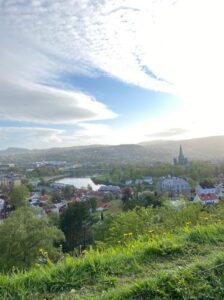
Trondheim in Summer – View von the Fortress
© Selina Fußwinkel
Daily Life in Trondheim
Trondheim is a rather manageable, small city, but very student-oriented. It didn’t take me
long to feel at home here and settle in. For students in particular, the heart of the city is the
Samfundet student house. It is run by students on a voluntary basis. Here you can find bars, a
restaurant and a café, several clubs and event rooms. You can go here every day and there is
always something going on. Parties at the weekend, concerts during the week, pub quizzes,
discussion evenings and my personal highlight: Wine-Wednesday. Apart from the student
house, however, the party life in Trondheim is rather lukewarm. If you like techno, you should
follow the Technophilia events on Facebook, as these are the only good techno parties here.
Otherwise, the bar “Circus” is highly recommended, where the music is rockier. For the
typical party nights, head to Fire Fine or Heidi’s Bierbar. In my opinion, that’s it for the
selection of good party options, so we often organized our own home parties.
Besides parties, Trondheim has a lot more to offer. The landscape with its location directly on
the fjord is beautiful. When the weather was good, we discovered barbecuing for ourselves,
either in the city by the river, at the meadows near the fortress or at Korsvika Beach. At least
once a week we went to the sauna. A particularly individual sauna can be found directly on
the coast, the Bunker Sauna. You have to heat it up yourself, though. There is also Havet.
Here you have to go at least once for the morning rave at 7 a.m., preferably on the first
Wednesday of the month, when you also get breakfast.
I also did a lot of sports here. The sports on offer are super varied and very cheap. For 120€,
you can go to the university gyms for the whole semester, attend classes here and try out all
the courses at NTNUI.
Trondheim has a lot to offer in terms of cuisine, although it is of course relatively expensive. I
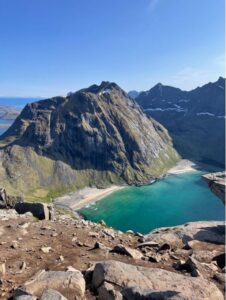
Lofoten Trip
© Selina Fußwinkel
can highly recommend the ramen restaurant “Koie”, the Olavshallen (here you can order
from 5 restaurants at once) and the pizza buffet in the Tyholt tower. It’s worth going here
anyway for the perfect view of Trondheim.
In and around Trondheim you can go hiking and skiing in winter. The Bymarka area is only
half an hour away. Here you can both hike and ski and stop at the Grønlia hut, which is
located right by the lake and offers a large selection of homemade cakes. It is also worth
taking a trip to Estenstadhytta and the Theisendammen viewpoint. The app Komoot also
offers some good routes in and around Trondheim.
As far as the weather is concerned, you really should be prepared for anything at any time in
Trondheim. The weather can change between sun, snow and rain a thousand times a day.
Sometimes you don’t see a single ray of sunshine for weeks, then suddenly it’s gloriously
summery. The darkness in winter worried me quite a lot at the beginning, because I usually
find winter in Germany terrible. And of course, it’s extremely dark and cold at the beginning,
but since everything is still very new at that time and so much is happening, there’s still no
time for tiredness and the time until it stays light a little longer passes super fast. I loved the
days when the sun didn’t set at all. The sleep rhythm gets absolutely out of balance, but
sitting in the park or on the beach at 3 a.m. in daylight is a very strange but very cool
experience.

Sunset at the Heinfjordstua
© Selina Fußwinkel
Excursions and Trips
One of my personal highlights: Our cabin trips. The university owns some cabins closer and
further away from Trondheim. You can stay here very cheaply and spend great weekends. We
went on a total of 3 of these trips. The cabins are sometimes in more or less good condition,
so you shouldn’t expect luxury, but you are always directly in nature and can hike to and from
the cabins. I can really recommend going to the newly built cabin called Mevasskoia on the
other side of the fjord
We also went on a road trip to Tromsø relatively early after our arrival in February. Also, one
of my highlights. I can only recommend everyone to do this trip by car and not by plane. The
road was scenically spectacular and a unique experience. We saw the northern lights on our
first day at our first stop, and then again on the following days. We also encountered some
moose on our way. We saw a lot of the country on this trip and got to know the winter in
Norway so far north in a completely different way.
In general, I would recommend everyone to take time to travel after the end of the semester.
Great destinations are the Lofoten Islands, the numerous national parks, Ålesund, Bergen
and possibly side trips to Sweden and Denmark on the way back.
Great experience in Norway
- Medicine
- Norway, Trondheim
- Norges Teknisk-Naturvitenskapelige Universitet
- 02/2023 – 04/2023
Introduction: My Erasmus+ traineeship experience of two months at the Department of Biomedical Laboratory Science at NTNU in Norway was a great experience, personally and professionally. This report aims to provide an overview of my journey, including the application process, accommodation, work environment, and the many activities that can be undertaken in Norway.
Application Process: I found a fascinating paper from the Department of Biomedical Laboratory Science and decided to apply for an internship. First, I called the department to ask about the possibility of an internship. Second, I submitted my application via mail in November. In January, I received a response from the university indicating the need to complete an online application. The whole process was straightforward if you followed the university’s instructions.
Accommodation: Finding accommodation in Norway was relatively easy. Sit, the Studierendenwerk of the NTNU, offers housing to all students (also Erasmus+ Traineeship Students). The rent was affordable, approximately 450 euros, especially when compared to other expenses in the country. Sit provides a range of student housing facilities throughout the city. After being offered a room in Steinan, I asked for a room in Moholt as I had friends from Aachen living there. The staff at Sit is very friendly and changed my offer. In Moholt, there are two types of accommodations: flats for four people with a shared kitchen and bathroom, or “the towers,” where 15 individuals share a kitchen, each having their own bathroom. I recommend “the towers” as they are newly constructed and offer fully equipped kitchens.
Transportation: Trondheim’s bus system is well-planned and provides convenient transportation options throughout the city. The busses come all 10 minutes, later in the day all 20 min. But with 50 euros per month, it is also costly.
Work Environment: On my first day, I received my key card, office key, and an office equipped with a second screen and a work laptop. Although usually an office is shared among three people, the office was mainly only used by me. The work culture in Norwegian labs and the hospital generally is more casual than in Germany. The hierarchy is flatter. For example, everyone gathered for coffee in the morning and had lunch together. Lunch is already at 11:30. I recommend bringing your lunch. That’s also what most others do, as food is expensive. My supervisors ensured that I was trained in every method before I had to work independently. I experienced a high level of appreciation for my work. I was very flexible in planning my lab week, which was cool!
Leisure time: Norway offers a wide variety of (outdoor) activities. If you’re a skiing enthusiast, Trondheim’s cross-country loipes are a must-do, and if you prefer alpine skiing, Vassfjellet is a good destination, located just 30 minutes by car or 60 minutes by bus from Trondheim. Of course, hiking is another great option to enjoy the landscape. Additionally, the university offers mountain cabins for rent (NTNU I member: 4 euros per person per night/ non-member: 8 euros pp pn). Boomerang and BUA are two spots where you can rent outdoor/sports equipment (cross-country ski, snowshoes, sleeping bag, tents, …) for free. If you prefer indoor activities, Sit has several gyms all over the city. There you can train by yourself or book courses. A spot can always be booked 48 h in advance; therefore, you can try out different ones. Apart from the gyms, you can book cheap Squash courts and go bouldering.
Conclusion: I recommend an internship in the Department of Biomedical Laboratory Science at the Faculty of Natural Sciences. The combination of friendly colleagues, a good work environment, and a wonderful country make it a great experience.
An incredible experience in Norway
- Psychology M.Sc.
- Norway, Tromso
- The Arctic University of Norway (UiT)
- 12.09.22-01.12.22
My experiences:
I recently completed a three-month internship at the UiT in Tromso, Norway during the fall. Overall, it was an incredible experience that I would highly recommend to anyone looking for an opportunity to gain valuable work experience while immersing themselves in a new culture.
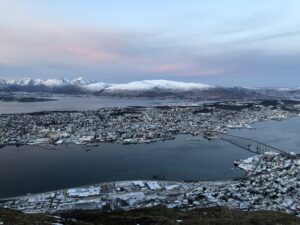
© Anton Koger
One of the biggest challenges I faced during my time in Tromso was finding social connections with native Norwegians. The city is quite small, and many locals tend to stick to their own social circles. However, I found that joining clubs and organizations related to my interests was a great way to meet new people and make friends. Additionally, the university has a very active international community, so it was easy to connect with other students from around the world.
The weather in Tromso can be quite challenging, especially during the fall when the days are short and the nights are long. However, the natural beauty of the area more than makes up for it. The scenery is absolutely breathtaking and there are plenty of opportunities to explore the great outdoors. One thing to keep in mind is that the lack of sunlight can be quite difficult to adjust to, so it’s important to make sure to get outside and soak up some sun whenever possible.
The university itself is quite international, with students and staff from all over the world. This made for a very diverse and stimulating learning environment. The work I did during my internship was very interesting and I felt like I was able to make a meaningful contribution to the research project I was working on.
As a secret tip, I would highly recommend visiting the PUST sauna in the harbour. It’s a unique experience where you can jump into the icy Arctic sea after sauna, it’s a great way to invigorate the body and mind.
In conclusion, my internship at the UiT in Tromso was an incredible experience that I would highly recommend to anyone looking for a unique opportunity to gain valuable work experience, immerse themselves in a new culture and enjoy the beautiful nature. The difficulty to find social contacts with locals can be challenging but with a bit of effort it’s totally worth it. The weather and nature are beautiful, but the lack of sunlight can be challenging. The university is very international and the work you did was very interesting. And don’t forget to check out the PUST sauna in the harbour where you can jump in the arctic sea.

© Anton Koger
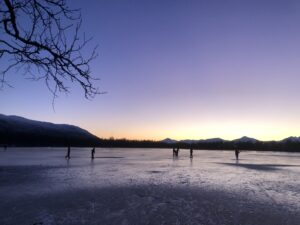
© Anton Koger

© Anton Koger
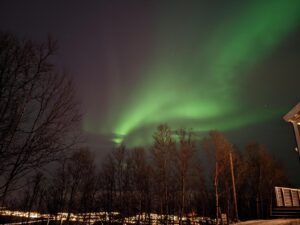
© Anton Koger
My experiences in Oslo
- Molecular and Applied Biotechnology (MA)
- Norway, Oslo
- University of Oslo (UiO)
- 01/10–30/11/2022
I completed a two-month research internship at the Department of Biomaterials of the University of Oslo (UiO). In the following, I would like to tell you about my experiences before and during my stay.
Finding an internship and an accommodation
Although my home university, RWTH Aachen University, does not have an Erasmus partnership with UiO, I came into contact with the institute through my student assistant supervisor, who completed his Bachelor’s thesis there. After a lot of back and forth about the date and topic of the internship, writing a project plan and applying for accreditation of the internship at my home university, the big challenge of finding a place to live began. Unfortunately, my application for student accommodation with SiO, the student organisation in Oslo, was rejected – probably because of my short period of stay – and I had to look for accommodation on the private market. I sent many requests on finn.no and hybel.no, most of which I didn’t even get an answer to, but in the end I had found a room in a 2-person shared flat and nothing stood in the way of my internship. To get there, I decided to go green and first took the train to Copenhagen, where I had a one-day stopover, and then continued by Flixbus through Sweden to Oslo.
The internship and my working environment
My workplace was the Department of Biomaterials at the Institute of Clinical Dentistry, which is part of the University of Oslo. It was essentially a research laboratory of the dental clinic, and most of the research conducted there had to do with dental implants in the broadest sense. I was warmly welcomed and integrated into the team from day one. We were an international research group with a few Norwegians and many scientists from all over the world. Apart from me, there were two other interns, a German and an Italian, and both were Master’s students just like me.
Compared to my experiences in Germany, the hierarchies at our institute were quite low and hardly noticeable, and social interaction was very important: Not only did we have lunch together every day, but we also had many nice conversations, especially on the days when someone had brought a cake or something typical from their home country after visiting or receiving visitors. Sometimes we also organised social events – for example, an international lunch on United Nations Day on 24 October: Everyone was assigned a country from which they had to cook and bring something typical. My country was Tanzania and I made vitumbua (coconut rice pancakes), a popular street food. Before Christmas, socialising became even more important, so on the last day of my internship, I sat in the lunch room with my supervisor, my professor and some other colleagues and folded paper Christmas stars while eating homemade gingerbread.
Although the working atmosphere was quite relaxed, we not only took breaks and drank coffee (which, by the way, was free for all employees, including interns), but also worked in the lab and were very productive in conducting experiments. My project was about validating a method to study cell adhesion to different surfaces. Since my internship was comparatively short, I already started to conduct my experiments independently after a one-week introduction. I had quite a tough schedule and on some days I had to give up my lunch break for the sake of the experiments, but my colleagues always supported and motivated me, so I was able to overlook this and very much enjoyed going to work. In the end, I had a lot of useful results that hopefully contribute to the progress of research on this topic. However, I did not only work on my project alone, but was also part of a project group in which my internship project was embedded. We had weekly meetings and one week we even had a two-day meeting with partners from other countries, where we shared results of previous research as well as ideas about future research tasks and planned the next steps. Of course, social events were also part of it, and so it happened that we not only played minigolf together, but they also took me to a fine dining restaurant, which was the first time in my life.
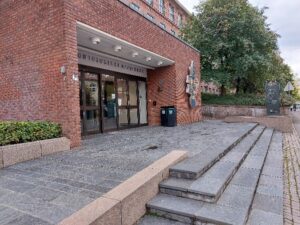 Entrance of the Institute of Clinical Dentistry © Friederike Götz
|
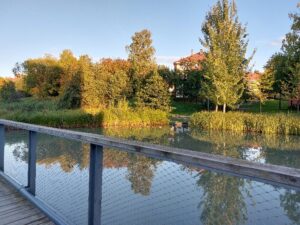 Pond right next to my flat © Friederike Götz |
Financial considerations
The cost of living in Oslo, as in all of Scandinavia, is quite high. My room rental was only two-thirds covered by the Erasmus+ funding, and the costs for daily needs such as food had to be paid on top of this, of course. At first I was a bit shocked by the prices in the supermarkets, which were sometimes twice (or even more) as high as in Germany. I didn’t go to restaurants often, which would have been even more expensive, and I didn’t buy alcohol – thanks to the high taxes on alcohol (and sugar) in Norway. But I have also found some ways to save money in everyday life: In the supermarkets, “Tilbud” is the word that indicates special offers. The weekly offers are often already sold out at the beginning of the week, but if you have the opportunity, it is worth taking it and getting groceries as well as cosmetics and other products much cheaper. Another insider tip is Grønland Frukt Og Grønt (located in Smalgangen 2), a shop where you can buy fruit and vegetables, but also spices and other foodstuffs at reasonable prices.
Free time in Oslo
At the beginning of the internship, the weather was still quite nice and I often explored the city after work and at the weekends. I had a student travel ticket that allowed me to drive all around the city and explore the city centre, the many parks, the harbour and lots of other sights. Since I love sports and play tennis in Germany, I didn’t want to give it up in Oslo either. There was a Facebook group to find tennis partners – which I made use of. Since the court rental was quite expensive, I often played in the morning before work, because then the prices – especially for students – were considerably cheaper. Although my institute had a small gym that I could use, I signed up for SiO Athletica, the student organisation gym that has several locations all over the city. I participated in some courses and on Sundays sometimes in walks that started in Kringsjå, the part of Oslo where the largest student housing is located. There is a beautiful lake there called Sognsvann with many hiking trails around it.
As my internship progressed, the days became noticeably shorter and the weather no longer invited me to spend too much time outside. These times were perfect for sauna visits. Together with some colleagues and friends, I booked a private group sauna that swam in the Oslo Fjord, with a beautiful view of the opera and the possibility to jump into the fjord if it got too hot inside.
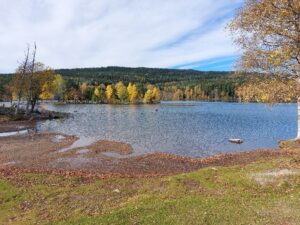
Sognsvann © Friederike Götz
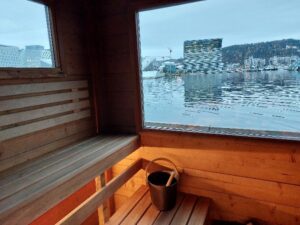
Sauna in the Oslo Fjord © Friederike Götz
Our weekend trip to the Nærøyfjord
One weekend, I went on a trip to the fjord scenery of Norway together with some of my internship colleagues. We rented a car (which was more difficult than expected, as we needed either a credit card or a Norwegian bank account, which neither of us had) and drove almost 8 hours to Voss, a municipality near Bergen. The drive took longer than expected because there was heavy rain that day and several times we came to places where a Norwegian stood next to a car with hazard lights on in the dark in the rain and told us that the road was closed and we had to take another route. In the end, we arrived at our accommodation right on the lake – which was now more or less in the lake, as our basement was flooded. Fortunately, the water had not damaged much and the upper floors were enough for us to sleep. So we were able to enjoy our weekend including an acquaintance with the unpredictable strength of Norwegian nature and a ferry trip on the Nærøyfjord, one of the two UNESCO fjords in Norway. The ferry went from Gudvangen to Flåm, a village famous for its railway, and was pleasantly empty as we were there outside the main season. Although the weather was not the nicest, the view was fantastic and I took many impressive photos that will always remind me of this unique experience.
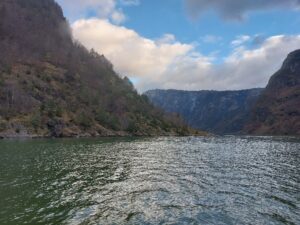
On the ferry in the Nærøyfjord ©Friederike Götz

View of the lake at our accommodation in Voss © Friederike Götz
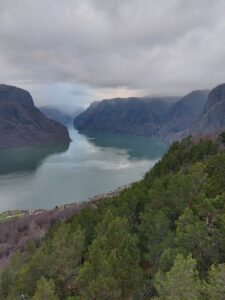
View of the Nærøyfjord from Stegastein viewpoint © Friederike Götz
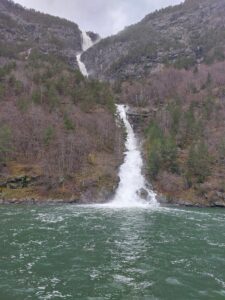
Waterfall in Nærøyfjord © Friederike Götz
My internship in Norway at Kverneland Energi
- M.Sc. Mechanical Engineering
- Norway, Kvernaland (living in Stavanger)
- Kverneland Energi
- 04.04.2022 – 30.06.2022
On April 1st I arrived in Norway and my first day of work was the 4th of April.
Kverneland Energi is a company that installs PV-systems, plans and installs battery systems and develops the software for projects that either just rely on generators and batteries or additionally use PV panels. My entry in the company started with learning the basic installation process of PV- systems on three different kinds of roofs:
1.flat roofs, which are mostly seen in industry applications
2.steel roofs often used in agriculture; a very interesting sector with wide availability of space for PV- systems and interest in the investment mostly to self-sustain the farmland; and
3. the classic gable roof with tiles, which can either have a hook-system to install the panels ‘on top’ of the tiles or alternatively the pricier option of an embedded PV-system
I worked for the first half of my three months stay in the installing sector of the company and got to know the difficulties and intricacies, which each different kind of project presents. The weather in April in Norway is tough
to predict and I experienced pretty much every time of the season in those 6 weeks –
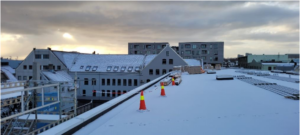
© Adrian Bodamer
starting with snow in week 1 of work and ending with summer like conditions in May, the part that needs most getting used to is the 8-hour work in constant rain. Stavanger is notorious for being city being blessed with rain, but thanks to the golf stream the extreme temperature drops are not too common there and therefor snow is rare. A one-hour drive to Sirdal is not only one of the most impressive road trips I have ever taken, it also completely changes the scenery and climate – presenting itself with at least half a meter of snow in the around easter.
That being said, I got quite lucky, and we mostly worked in sunny weather conditions – with wind presenting the biggest challenge. Carrying and installing the panels in these conditions can be very tricky and presents the engineers with the challenge of providing a system that is able to sustain all kinds of weather challenges on a constant basis.
After 6 weeks outside I joined the software programmers in the office space in Kvernaland, around 30minutes outside of Stavanger. There I worked closely with Andreas, an electrical engineer on a project which runs off grid. The cabins located in ‘Stranddalen’ are about a 1.5h hike away from the next closest village and require an energy system without a grid connection – relying on a generator and sunlight.
With a combination of a large generator, solar panels, and a battery system the cabins can self- sustain for the
3-4 month opening period, starting
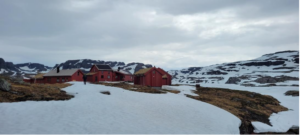
© Adrian Bodamer
in the middle of June. During the winter, the batteries are discharged and must handle temperatures around -10°C over weeks, the panels need to sustain meters of snow pressing down on them. All these extreme weather conditions make this project incredibly exciting!
This project started as the bachelor thesis for Andreas, and my job for most of my time in the office was to program a updated plan to improve the efficiency of when the generator needs to be active, and when the PV-power and battery system can supply the cabins without the use of fuel. Challenging in that was the variation in consume, produced PV current and request of the customer to not run the generator from 9pm to 8am. The battery system is the most important thing to avoid running the generator too often and use unnecessary fuel. Working with data collected over the last 2 years and realising patterns about consume and production, Andreas, Sjur and I implemented the new code created in TIA portal by visiting the cabin and accessing the electric system at the cabins.
Before the visitors and personal come to the cabin, the new system needed to be implemented. A 2-hour hike with increasingly more snow on the path the further we went up the mountain in the middle of June was one of my most surreal
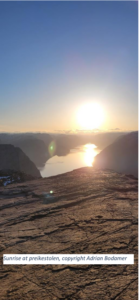
© Adrian Bodamer
experiences and showed me (once again) the stunning beauty of Norway! And the 2-day stay with my two Norwegian co-workers that I had to this point known for only a few weeks was amazing and I always felt very welcome – and that was the case pretty much everywhere I went in Norway.
Without ERASMUS, this trip would have not been possible for me – it was tough to find a place to live for short term rent that was also affordable. Same goes for every day needs like groceries or public transport tickets – everything is more expensive here, without exception. If you plan on having a less stressful time in Norway, then a good approach would definitely be to make a spending plan before arriving. And if you have a car, I would very much advise you to drive it up to Norway if you want to see much of the country as public transport is definitely improvable to say the least. My 17-hour trip from Aachen to Stavanger by car was exhausting but the best decision I made coming up here – though not very sustainable I have to admit. If you ever get the chance to travel to Norway: take it, it’s absolutely worth it!
My experiences in Trondheim, Norway
- Business Administration and Engineering Materials and Process Engineering, M. Sc.
- Trondheim, Norway
- NTNU Trondheim
- 01.04.2022 – 31.05.2022
My experiences:
I am solely responsible for the content of this report.
During my master thesis which I am writing in collaboration with the NTNU in Trondheim and RWTH in Aachen I spent two months in Trondheim.
Preparation
Since I was already in Trondheim the semester before as an exchange student, I was quite familiar with the city, university as well as with the application procedure. During my exchange semester I attended the course MFA I (Material Flow Analysis) with Prof. Müller and decided to write the upcoming master thesis together with him and the RWTH.
After gathering some information, the application was very easy and quick. The next step was then the application/registration at the NTNU to get the student rights etc. and to be also able to apply for student accommodation through SIT (the organisation which provide the accommodations and other things in Trondheim). I received the confirmation of both in time so I could plan all the rest.
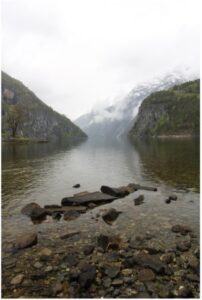
© Moritz Langhorst
Office routine
During the two months I felt very welcome at the department and was able to work in the study room with all the other students writing their master thesis. This was a good way to get to know them and to see on which topics the other students and researchers in the group are working. My weekly meetings with my supervisors could now also take place in person, which was very helpful for the working progress. I could also participate in the regular group meetings of the research group where the researchers of the group are presenting their work.
Leisure
Because I still knew some people from my exchange semester, it was very easy to find a lot of activities for the time besides the thesis. On weekends we went on a lot of cabin trips in the surrounding area, spent evenings on the fjord to watch the sunset, went bouldering or in bars. Trondheim has especially for students a lot to offer. A very nice coincidence was that the 17th of May, which is the national holiday in Norway, was in my time in Trondheim. This was a perfect opportunity to get to know the Norwegian culture, starting with a brunch and parades in the city.

© Moritz Langhorst
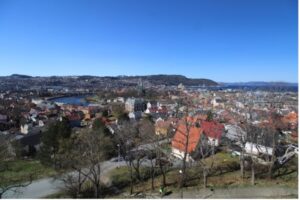
© Moritz Langhorst
My research stay in Oslo
- Chemistry M.Sc.
- Norway, Oslo
- Universitetet i Oslo
- 12.09.21-12.03.2022
Over the course of my studies, played with the idea of doing an exchange, though, for various reasons, I never went through with it. With the end of my master’s degree approaching, I decided to make use of this last chance and to complete my master thesis during a research stay at a university in another country. The planning for this started in May 2021, at the height of the second COVID wave. This narrowed my choice of countries down to all of Scandinavia, since the situation there was somewhat calm, though at this point the borders were still closed, and it wasn’t clear when they would open again. Nonetheless, I started planning.
After looking at all the major universities in Scandinavia, I found that UiO (Universitetet i Oslo) and UiB (Universitetet i Bergen) did interesting research that aligned well with my qualifications, but also with skills that I still wanted to acquire or improve. After contacting a professor at each university by e‑mail, Prof. Tilset from UiO was able to accommodate me for an interesting project in the desired timeframe.
At first, I tried to find housing privately on finn.no (Norway’s equivalent to eBay), but as a foreigner, a male, and someone staying for a mere few months, it is very difficult to find a place in shared accommodation. Thankfully, the Department of Chemistry offered to apply for researcher housing for me. Most of the student housing in Oslo is run by SiO (Studentsamskipnaden i Oslo og Akershus), a student welfare organization. Their housing is well-maintained and somewhat modern, though as a researcher you pay 20% more rent than students. Electricity, water, and internet access are included in this. This is still cheaper than the very expensive private housing in Oslo. I paid 4800 NOK in rent for a room with a shared kitchen (6 people), which is about 480 €. Having to pay more as a researcher was a recurring theme for my stay in Oslo, since I mostly didn’t get student discounts. As another bonus, you get housed with other students of Oslo’s universities, so you have ample opportunities to make friends. On the day of your arrival, it might make sense to make use of the hourly Ikea shuttles, which take people from the city centre to one of two Ikea markets (free of charge). This lets you buy the necessities for your room/apartment conveniently. The location and departure schedule can be found on Google Maps.
When staying in Norway for more than 9 weeks, it is mandatory to register with the police, where (if you’re an Erasmus intern as opposed to an Erasmus student) you have to document that you have enough money to support yourself (e.g. savings, the equivalent of 180.000 NOK per year, or less if you’re staying for a shorter time), a valid national identity card/passport and private health insurance. I did not know of the latter, but the worker at the police was kind enough to register
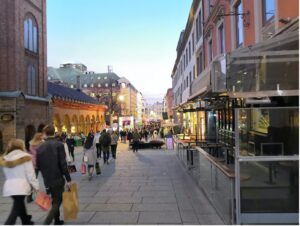
© Heiko Schiefer
me as a student when I showed her the signed agreement of the three parties and proof that I received funding from Erasmus (in my case a bank statement).
Oslo has good public transportation (Metro, Tram, Busses, and Boats), but the normal monthly ticket (800 NOK) unfortunately is constrained to the city limits, which nonetheless should cover most of your trips. Extensions can be bought in the public transportation company’s app, Ruter.
Since you will be paying in NOK, it also makes sense to open an account with a bank that charges no fees for paying in foreign currency, e.g., DKB. Credit cards are universally accepted, so there is little reason to carry cash.
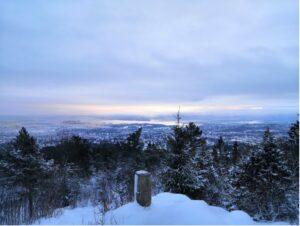
© Heiko Schiefer
For leisure activities, the Norwegians are generally very fond of the outdoors, so popular activities are ice skating, skiing, or hiking, sometimes combined with a picknick. Outdoor equipment can be borrowed free of charge at one of the many Bua’s (a non-profit organization) around Oslo. During the winter, many people sit around campfires around lake Songsvann or atop the Vettakollen mountain. These are also nice places to try and get a glimpse of the northern lights. The Norwegian trekking association (DNT) organizes trips (e.g. mushroom picking or hiking) and rents out cabins for cheap. If going out to eat is more your thing, Oslo Street Food is worth recommending. It’s a cozy food court with lots of selection, but don’t expect to be served large portions.
Here it should be mentioned that the selection of vegetarian food is more limited in Norway than in Germany, and vegan food even more so. If you’re a big partygoer, beware: Alcoholic beverages are very expensive in Norway, and only sold until 8 pm. Anything over 4.7% is only sold in the state-run Vinmonopolet shops. If you’re more culturally inclined Oslo’s many museums might be of interest.
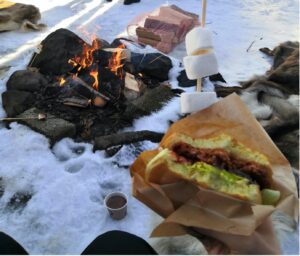
© Heiko Schiefer
Because I did not need to attend any courses, I could focus solely on my research and enjoyed lots of autonomy. The university is generally well equipped. I had my own lab bench and fume hood in a large lab with 5 other researchers (Bachelor/master students, PhDs, and a post-doc), as well as a desk in a shared office. Approximately half of the researchers were Norwegian, the other half from all over Europe. The direction and progress of my research was evaluated in weekly talks with my supervising Professor. In addition to that, there were weekly group meetings and biweekly section meetings, were people would present their research and the rest would give feedback/ask questions. The working climate was very pleasant, and I spent hours talking to fellow researchers about their or my research.
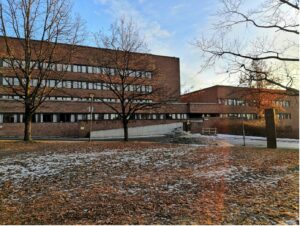
© Heiko Schiefer
In conclusion, my time in Oslo was a great experience, both professionally and personally. I got to do research abroad, acquired new skills, and refined those I already had. I met lots of new people and made friends and memories. While the cost of living is certainly high in Oslo and coming to Norway as an intern is associated with some challenges, the experience was certainly worth it.

